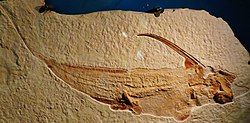Biology:Ischyodus
| Ischyodus | |
|---|---|

| |
| Ischyodus quenstedti | |
| Scientific classification | |
| Domain: | Eukaryota |
| Kingdom: | Animalia |
| Phylum: | Chordata |
| Class: | Chondrichthyes |
| Subclass: | Holocephali |
| Order: | Chimaeriformes |
| Family: | Callorhynchidae |
| Genus: | †Ischyodus Egerton, 1843 |
| Species | |
| |
Ischyodus (from Greek: ισχύς ischýs, 'power' and Greek: ὀδούς odoús 'tooth') is an extinct genus of chimaera. It is the most diverse and long-lived chimaera genus, with over 39 species found worldwide spanning over 140 million years from the Middle Jurassic to the Miocene.[1] Complete specimens of I. quenstedti from the Late Jurassic of Germany most closely resemble the genus Callorhinchus amongst living chimaera genera.[2] It is sometimes placed in the "Edaphodontidae", a unclearly defined group of chimaera with an uncertain position within the clade,[1] while other authors place it into Callorhinchidae along with Callorhinchus.[3]
Based on complete specimen, total length is 21 times larger than mesiodistal length of mandibular tooth plate. For example, I. bifurcatus with mandibular plate length of 3.2 in (8.2 cm) possibly belongs 5 ft 8 in (1.72 m) long specimen.[4]
References
- ↑ 1.0 1.1 Johnson-Ransom, Evan D.; Popov, Evgeny V.; Deméré, Thomas A.; Shimada, Kenshu (October 2018). "The Late Cretaceous Chimaeroid Fish, Ischyodus bifurcatus Case (Chondrichthyes: Holocephali), from California, USA, and Its Paleobiogeographical Significance" (in en). Paleontological Research 22 (4): 364–372. doi:10.2517/2018PR004. ISSN 1342-8144. http://www.bioone.org/doi/10.2517/2018PR004.
- ↑ Popov, E. V., Duffin, C. J., Tischlinger, H. and Atuchin, A., 2013: Reconstructions of the German Plattenkalk (Late Jurassic) chimaeroid fishes (Holocephali, Chimaeroidei). In, Schwarz, C. and Kriwet, J. eds., Sixth International Meeting on Mesozoic Fishes: Diversification and Diversity Patterns. Abstracts, p. 56. Verlag Friedrich Pfeil, Munich
- ↑ Otero, Rodrigo; Figueroa Bravo, Constanza; Soto Huenchuman, Paula; Fernández-Collemann, Sara; Valenzuela Toro, Ana; Gutstein, Carolina (2021). "First record of Ischyodus (Chondrichthyes, Holocephali) from the Upper Jurassic of southwestern Gondwana". Acta Palaeontologica Polonica 66. doi:10.4202/app.00859.2020. ISSN 0567-7920. http://dx.doi.org/10.4202/app.00859.2020.
- ↑ Johnson-Ransom, Evan D.; Popov, Evgeny V.; Deméré, Thomas A.; Shimada, Kenshu (2018-10-01). "The Late Cretaceous Chimaeroid Fish, Ischyodus bifurcatus Case (Chondrichthyes: Holocephali), from California, USA, and Its Paleobiogeographical Significance" (in English). Paleontological Research 22 (4): 364–372. doi:10.2517/2018PR004. ISSN 1342-8144. https://www.researchgate.net/publication/328044465_The_Late_Cretaceous_Chimaeroid_Fish_Ischyodus_bifurcatus_Case_Chondrichthyes_Holocephali_from_California_USA_and_Its_Paleobiogeographical_Significance.
External links
Wikidata ☰ Q147293 entry
 |

